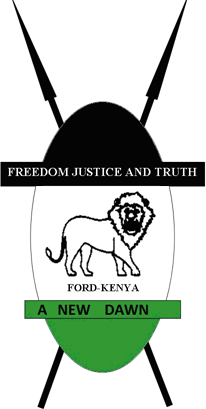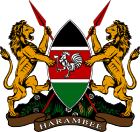
Daniel Toroitich arap Moi was a Kenyan politician who served as the second president of Kenya from 1978 to 2002. He is the country's longest-serving president to date. Moi previously served as the third vice president of Kenya from 1967 to 1978 under President Jomo Kenyatta, becoming the president following the latter's death.

The Kenya African National Union (KANU) is a Kenyan political party that ruled for nearly 40 years after Kenya's independence from British colonial rule in 1963 until its electoral loss in 2002. It was known as Kenya African Union (KAU) from 1944 but due to pressure from the colonial government, KAU changed its name to Kenya African Study Union (KASU) mainly because all political parties were banned in 1939 following the start of the Second World War. In 1946 KASU rebranded itself into KAU following the resignation of Harry Thuku as president due to internal differences between the moderates who wanted peaceful negotiations and the militants who wanted to use force, the latter forming the Aanake a forty, which later became the Mau Mau. His post was then occupied by James Gichuru, who stepped down for Jomo Kenyatta in 1947 as president of KAU. The KAU was banned by the colonial government from 1952 to 1960. It was re-established by James Gichuru in 1960 and renamed KANU on 14 May 1960 after a merger with Tom Mboya's Kenya Independence Movement.

Elections in Kenya take place within the framework of a multi-party democracy and a presidential system. The President, Senate and National Assembly are directly elected by voters, with elections organised by the Independent Electoral and Boundaries Commission (IEBC).

Forum for the Restoration of Democracy–Kenya (FORD–Kenya) is a Kenyan political party. The party has sat in the government of Kenya once, under the National Rainbow Coalition, from 2003 to 2007, having ended forty years of one party rule. In April 2022, the party joined the Kenya Kwanza coalition for the August 2022 elections, and is headed by Moses Wetangula, the current speaker of the National Assembly of Kenya. The party tends to be more popular among the Luhya people.
Henry Pius Masinde Muliro was a Kenyan politician from the Bukusu sub-tribe of the larger Abaluhya people of western Kenya. He was one of the central figures in the shaping of the political landscape in Kenya. An anti-colonial activist, he campaigned for the restoration of multi-party democracy in Kenya in his later years.

George Musengi Saitoti, E.G.H. was a Kenyan politician, businessman and American- and British-trained economist, mathematician and development policy thinker.

General elections were held in Kenya on 27 December 2002. Voters elected the President, and members of the National Assembly. They coincided with the 2002 Kenyan local elections.

General elections were held in Kenya on 27 December 2007. Voters elected the President, and members of the National Assembly. They coincided with the 2007 Kenyan local elections.

General elections were held in Kenya on 29 December 1992 to elect the president and members of the National Assembly. They were the first multi-party general elections in Kenya since independence and the first to feature a direct vote for the president, who had been elected by the National Assembly in 1964 and been automatically declared the winner of uncontested elections held alongside parliamentary elections in 1969, 1974, 1979, 1983 and 1988 following a 1969 constitutional amendment.

General elections were held in Kenya on 29 December 1997 to elect the President and the members of the National Assembly. The result was a victory for the ruling Kenya African National Union, which won 107 of the 210 seats in the National Assembly, and whose candidate Daniel arap Moi won the presidential election. Following the election, Moi appointed a further 12 members to the Assembly.
Kipkalya Kiprono Kones was a Kenyan politician who served as a minister during the 1990s and was briefly Minister of Roads in 2008. He was a member of the National Assembly of Kenya from 1988 to 2008.
Gideon Musyoka Ndambuki is a Kenyan politician. He has been the Kaiti Constituency MP since 1997 when the constituency was established, and was a minister between 1998 and 2002. At the 1997 and 2002 elections he won the seat representing the KANU party, but represented the Orange Democratic Movement-Kenya at the 2007 Kenyan parliamentary election. He unsuccessfully vied for the Makueni County Senate seat during Wiper Democratic Party nominations in the run-up to the 2013 General Elections in Kenya. Educated in the US, he was an employee of the Commercial Bank of Africa in the 1980s, and more controversially, Managing Director of Trade Bank between 1986 and its collapse in 1993.
Belgut is an electoral constituency in Kenya. It is one of six constituencies of Kericho County. The constituency was established for the 1963 elections. A new Constituency Sigowet-Soin was curved out of this Constituency in 2013 after the promulgation of the new constitution (2010).

General elections were held in Kenya on 6 December 1969, the first since independence in 1963. The country had become a de facto one-party state after President Jomo Kenyatta had banned the Kenya People's Union on 30 October, with Kenyatta's Kenya African National Union being the sole party to participate in the election. Although the post of President of Kenya was due to be elected at the same time as the National Assembly, Kenyatta was the sole candidate and was automatically elected without a vote being held.

General elections were held in Kenya on 14 October 1974. At the time, the country was a de facto one-party state with the Kenya African National Union being the sole party to participate in the election. 740 KANU candidates stood for the 158 National Assembly seats, with 88 incumbents defeated. Voter turnout was 56.5%. Although the post of President of Kenya was due to be elected at the same time as the National Assembly, Jomo Kenyatta was the sole candidate and was automatically elected without a vote being held. Following the election, a further 12 members were appointed by Kenyatta.

General elections were held in Kenya on 8 November 1979. At the time, the country was a de facto one-party state with the Kenya African National Union being the sole party to participate in the election. A total of 742 KANU candidates stood for the 158 National Assembly seats, with more than half of the incumbents defeated. Voter turnout was 67.3%. Although the post of President of Kenya was due to be elected at the same time as the National Assembly, Daniel arap Moi was the sole candidate and was automatically elected without a vote being held. Following the elections, a further 12 members were appointed by President Moi.

General elections were held in Kenya on 26 September 1983. At the time, the country was a one-party state with the Kenya African National Union having been made the sole party the previous year. More than 750 KANU candidates stood for the 158 National Assembly seats, with around 40% of incumbents defeated. Voter turnout was 45.9%. Although the post of President of Kenya was due to be elected at the same time as the National Assembly, Daniel arap Moi was the sole candidate and was automatically elected without a vote being held. Following the elections, a further 12 members were appointed by President Moi.
Peter Adhu Awiti was a Kenyan politician who served as a member of the National Assembly for Karachuonyo Constituency from 1997 until 2007. He also served in former President Daniel arap Moi's final government cabinet as Minister for Planning from 2001 until 2002.

The presidency of Daniel arap Moi began on 22 August 1978, when Daniel arap Moi was sworn in as the 2nd President of Kenya, and ended on 30 December 2002. Moi, a KANU party member, took office following the death of the then president Jomo Kenyatta on the same day. He was sworn as interim president for 90 days during which the country was to prepare for a presidential election to be held on 8 November. Moi won reelections in 1988, 1992 and 1997, defeating Mwai Kibaki in the latter two elections. He was succeeded by Mwai Kibaki in 2002. He died at the age of 95 on 4 February 2020










